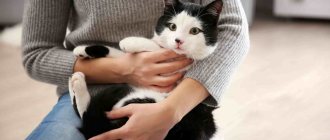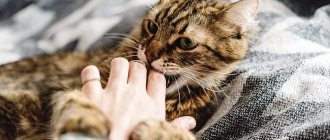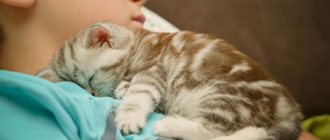How purring occurs
The mechanism of rumbling in cats is similar to what allows large representatives of the cat family to roar and roar. Contraction of the muscles near the vocal cords vibrates the hyoid bone. From the base of the tongue, the trembling spreads throughout the animal’s entire body, which creates the impression that a “built-in purr” is located in the stomach.
But the physiology of tigers and lions allows this sound to be made only when exhaling; this is due to the rectangular shape of the bone under the tongue. In cats, this organ has the shape of a triangle, so they are able to purr continuously. The lynx and forest cat can also purr.
Why do cats purr like a tractor?
1Mar – 31 All day 20% DISCOUNT ON 4lapy DIETARY CAT FOOD. ru Animal: Cats
Only from March 1 to March 31, we are giving a 20% discount on Hill's Metabolic food for sterilized and neutered cats.
1Feb - 31Mar All day 30% DISCOUNT ON FASHIONABLE CLOTHES 4MYPETS petshop. ru Animal: Cats, Dogs
4MyPets clothing will help you cope with weather surprises in the autumn season! Raincoats, sweatshirts, tracksuits, overalls with a 30% discount. Offer limited by product availability.
1Mar — 31 All day PARASITE DROPS VECTRA 3D: 3 FOR THE PRICE OF 2! 4lapy. ru Animal: Cats, Dogs
Purring mechanism
Why do cats purr when you pet them, by what mechanism does a cat purr occur, what does it mean and where is the purr itself located? And why do cats purr very loudly when you pet them? After all, everyone knows that when you pet them, the cat purrs much louder. Such questions have probably come to the minds of many people. And the answers to them were found by a science called bioacoustics. There are actually several theories that explain why cats purr:
The purr is directly the mechanism responsible for the cat's purring. It consists of small bones connected to each other. The bones of the urchin extend from the pet's head to the base of the tongue. Essentially, a cat's purring causes the vocal cords to vibrate. After all, it is this part of the urcal that causes vibration in the hyoid bones, which contributes to the appearance of such an original sound.
The purring of a cat is typical for a pet not only when exhaling, but also when inhaling. This is also determined by the location of the urcal itself. For example, older relatives of the cat family - lions, tigers, panthers, leopards - do not have this mechanism. Accordingly, these animals will never rumble.
More details
Yesterday we bought a British kitten at an exhibition :) While we were driving home in the car, he sat in my arms, and I think he even peed a little at first. then after a while it started purring :)
His appetite is brutal, but we give him food in moderation so that he doesn’t overeat (as the breeder advised). For some reason I haven’t drunk any water yet. Very active, loves to play. The kitten lives with us for exactly one day :)
So why do cats purr and cats purr? The mechanism by which cats purr is not fully understood. But the opinions of scientists are unanimous - vibration in the larynx of animals is accompanied by emotions.
Some felinologists say that a cat purrs due to the vibrations of its lungs. Others talk about blood circulation. But there is a generally accepted scheme.
The vocal cords begin to work using electrical impulses. The details are not important, but the impulses are generated in the animal's brain. Having made a short journey to the murmur apparatus, to the hyoid bones, they initiate sound.
The cat purrs both when inhaling and exhaling. But large cats do not vibrate with their voices. Imagine a purring lion: this is something from the realm of fantasy. So, they also voice, but with a roar. Large cartilages help them growl, while in small animals they are smaller.
When and why do cats purr and cats purr? Whenever they want! Moreover, sometimes the sound is so loud when the mouth is closed that it is unrealistic to hear the cat’s heart beating or how it breathes. And it also happens that animals that never purr, if they find themselves in a different situation, can begin to do so.
So what are the reasons for purring?
For kittens, this is a way of communicating with their mother cat. It starts on the second day of their life! How can you communicate your contentment and satiety while sucking milk? Mommy responds in kind.
Why do adult animals need this? According to science, in moments of pain or joy, endorphins are released in the feline brain. Their role is to suppress pain and induce euphoria. As we will see below, this happens in different situations. That’s why it’s so important for us, the owners, to pay attention to these sounds. What if we miss something important?
Why does a cat purr?
People often perceive purring only as an expression of pleasure. In most cases, this is true - a satisfied, well-fed, relaxed cat begins to purr reflexively. But there are other reasons:
- A way to calm down. Cats often purr when they are about to fall asleep, or, for example, when a stranger appears in the house and this disturbs them.
- Showing friendliness. By purring, cats can express affection both to humans and to their relatives. It has been noticed that males sometimes purr next to sick or weaker individuals. In cat language this means “I will not attack.”
- Trying to beg for food or attention. Tailed cunning creatures know that a person cannot resist their purring, and they actively use this “argument” when they need something.
- A way to relieve pain. Wounded, sick, and giving birth cats often purr. At this moment, endorphins are released in the cat’s brain, which reduces sensitivity to pain.
Too frequent and prolonged purring of a cat can signal dangerous diseases!
Specifics of sounds made by cats
A cat purrs when it feels pleasure and more
Many owners of furry pets have probably wondered why cats purr. In order to communicate with people or other animals, cats use various types of communication. Rumbling is one of them. A pet can show its mood through various gestures, the position and vibration of its tail, and also by making sounds.
First, let's look at what is meant by rumbling.
The rumbling and purring that the mustachioed-striped one makes is accompanied by rhythmic vibration in parts of the animal’s body. This is one of the ways of communication, healing and reassurance, reporting the animal's condition.
Interesting: Only felines can purr.
The benefits of purring for humans and animals
It is believed that a cat’s purring has a beneficial effect on both humans and the source of pleasant sounds. Since the frequency of rumbling sound vibrations is 20-44 Hz, it can stimulate regenerative processes similar to ultrasound.
Cats heal: hugs and purrs help lower blood pressure, normalize heartbeat and cope with stress. A cozy purring cat is especially useful for people suffering from nervous diseases.
A study from the Mayo Clinic in Arizona found that among patients suffering from insomnia, 41% fell asleep better while cuddling a cat.
For the animal itself, rumbling is useful because it promotes the production of hormones that strengthen bone tissue. This is a kind of “gymnastics” that partially replaces physical activity.
A little relaxing purring in the video
Why might an animal bite while ironing?
It always looks very strange when you pet your pet, and he seems to purr, but suddenly bites you, trying to open the veins. In fact, this behavior does not mean at all that your pet is unhappy. He doesn't mind demonstrating his love, but at the same time he is categorically against you touching him now. There is also a possibility that you touched him or stroked him incorrectly.
How to determine by purring what a cat wants
Purring is, first of all, a way of communication, and it can tell the owner how his pet is feeling and what his pet needs.
- If the cat “hums like a tractor,” loudly and reverberatingly, it means he is happy with everything. When the animal's body is relaxed, the tail does not move, the eyes are half closed, and purring also expresses pleasure.
- If your cat purrs quietly, it may be dozing or bored.
- A soft but loud purr is an attempt to attract attention. A hungry cat, moreover, from time to time interrupts its rumbling with a shrill meow, runs restlessly around the apartment, and makes deliberate noise.
- If a cat purrs while lying next to a person, it expresses sympathy for the owner. Particularly indicative is the rumbling, which begins with high notes and ends with low sounds.
- If the cat has become lethargic, eats poorly, or has difficulty going to the toilet, purring does not mean an improvement in his condition. On the contrary, constant purring should alert the owner.
Rumbling is a sign of peace and more
Many of us believe that since a cat purrs, then everything is fine. But, unfortunately, such uterine sounds are not always a sign of pleasure or satiety. Let's see in what cases you can hear a cat purring:
- Possessive rumbling
- if a cat tramples with its front paws and purrs, then one can suspect that this is how the animal marks the owner in a unique way, making it clear to the person that the head of the house is His Majesty the Cat;
Rumbling as a sign of pleasure from communicating with a person
– almost all cats purr when they are petted, but suddenly stop doing this when they get tired of the owner’s touch;
Rumbling as an attempt to help yourself
– sometimes a cat purrs like a tractor if something hurts. So, a pet may well purr, licking its wounds after a collision with a neighbor’s dog. A cat can purr during a fracture caused by a fall from a height, during childbirth, or during an exacerbation of any chronic illness. It's sad, but sometimes animals purr even before they die, perhaps trying to calm themselves down;
Purring as a signal of calm for kittens
– if you watch a nursing mother and her cubs, you will notice that the cat moves her paws and purrs when the kittens suckle her milk. Rumbling at such moments is necessary for babies to feel safe;
Rumbling as a sign of a peaceful attitude
– sometimes cats can purr in front of each other. They do this in order to demonstrate goodwill to other individuals;
Rumbling as an accompaniment to sweet slumber
– cats cannot purr in their sleep, but during rest and dozing they can purr quite well. Especially in situations where a delicious lunch has been eaten and there is no threat around;
Rumbling as an anticipation of something good
– our pets begin to purr when they anticipate that something pleasant or tasty is waiting for them. So, a cat can easily start “singing” loudly if he sees that the owner is sitting down in a chair (it’s time not just to watch TV, but also to pet the cat!). Or you can hear the purring of an animal that has seen and felt that the owner has begun to cut up fish or meat in the kitchen;
- Rumbling as an attempt to cure the owner
- many owners know that cats can predict a person’s mood, and also feel when a person is not feeling well. For example, if a cat owner has a heartache, then the pet can easily lie down on the cat’s chest and begin to purr and rumble. This is how the animal tries to help the owner cope with pain.
So, there are many reasons for a cat’s purring. But how can you recognize when an animal makes such sounds from pleasure and when from pain? It turns out that cats always purr in different ways. Thus, a loud rumbling at a frequency of about 50 Hz may indicate that the pussy is trying to cope with the pain of a fracture or dislocation, and a rumbling at a frequency of 100 Hz or more may indicate that the animal is suffering from some kind of chronic disease.
In addition, the vigilant owner will be able to notice the state of ill health by other alarming symptoms in addition to loud rumbling: elevated temperature, upset stool, vomiting, limping, and so on. And if an animal purrs quietly at a low frequency of up to 35 Hz, closing its eyes and tucking its paws under itself, then it is probably in calmness and in a good mood.
Why doesn't my cat purr at all?
Some cats never purr. Veterinarians say that the tendency to purr is an individual trait that depends on the character of the pet. The breed influences to a lesser extent, but, for example, Devon Rex almost do not make such sounds. In addition, some cats purr silently - you can only feel a slight vibration if you put your hand on the cat's chest or stomach.
You should only worry if the cat has stopped purring. This may indicate resentment of the pet, distrust of the owners, and a feeling of being superfluous. This often happens after the birth of a child in a family. It may also be a symptom of a respiratory tract disease. First, you should visit a veterinarian, and then a zoopsychologist.
What does it mean when a cat purrs?
Biologists are still deciding what it means when a cat purrs. It is wrong to think that cats purr solely from pleasure. This thesis is easy to refute. Cats purr at a veterinarian's appointment, in pain. There can be no talk of pleasure.
Animals make sounds for some purpose. Kittens' purring begins to work already on the third day after birth. There are several options for interpreting sounds. Attentive owners catch the difference in sounds and guess what it means when a cat purrs during childbirth or feeding babies. The cat either gives signals that everything is fine with it or warns of danger, it all depends on the tone of the purring.
True Touch Glove for combing wool
Price: 530 rub. 899 rub. 41% discount for you!
An alternative to slicker brushes and combs. Fast delivery throughout Russia. And also more than 3,000 other pet products at competitive prices! Take a look!
Purring comes in different forms. Observant owners of mustachioed pets have learned to understand them with just one word. They understood what it means when a cat purrs, and identified several groups of purring:
- a dissatisfied rumbling indicates pain or dissatisfaction;
- if the muffled purring turns into a rumbling, then the cat is very nervous;
- With a quiet purr, the mother cat warns the babies of danger;
- with loud rumbling sounds, a nursing cat prohibits a person from approaching the kittens;
- a rough purr indicates that the cat is happy with everything;
- the subsidence of the sound indicates fading interest in what is happening.
In the process of observing the animal, an understanding comes of what it means when a cat purrs constantly. This is how the animal tries to attract the owner’s attention to its person. Veterinarians have figured out how to stop a cat from purring. They turn off the water tap and the animal falls silent. Such actions have to be resorted to forcedly. After all, it is impossible to listen to a cat when it purrs.
Find out what it means when a cat purrs in its sleep. There is a version that cats keep their muscles toned this way. The assumption is not without meaning. After all, cats spend 95% of their time sleeping. Muscles can also atrophy. To prevent this from happening, cats purr.
The researchers had to use special equipment to find out at what frequency the cat purrs. Animals make sounds with a frequency of 25 to 150 Hz. Such vibrations increase bone density and heal wounds. Consequently, cats treat themselves in this way.
Cats don't exercise their muscles, but their bodies are graceful and flexible. The explanation for this phenomenon is rumbling. A working purr maintains healthy bones and muscles. Doctors say that it is also useful for humans when a cat purrs, that it treats various diseases in this way. Americans used vibrations with a frequency of 25 Hz to restore the muscular system of astronauts.
Research has been conducted to find out what it means when a cat purrs when experiencing pain. The cat turns on its purr to relieve stress. This is a kind of pain reliever. Purring stimulates your pet's brain to produce hormones responsible for relaxation and wound healing.
If the physiological basis of rumbling was found out, the reasons for this phenomenon could not be fully understood. Take a closer look at your pet and find out what it means when a cat purrs. Each animal is an individual. One cat's purr will be different from another. An attentive owner will notice changes and react sensitively to them.
Backpack carrier for cats with porthole
Price: 3490 rub. 3990 rub. 13% discount for you!
A bright and original carrier for cats. Fast delivery throughout Russia. And also more than 3,000 other pet products at competitive prices! Take a look!
What you didn't know about purring
- Are cats afraid of water? But the sound of its flow fascinates them! The purring of a cat can be stopped by the sound of flowing water.
- Cats are good teachers. It turns out that there was a case when a small dog made sounds similar to purring. It turned out that the puppy was raised and lived in a cat family.
- The ability to purr is given to cats from birth. They do it well from the first days of life.
- The ability to purr is used between the tails for communication. This is how they show each other friendliness or show aggression. And the difference lies in timbre, rhythm, intonation and vibration volume.
- There is “purring therapy” which was developed by British specialists. This therapy is aimed at pain relief. Scientists have proven that this is exactly the effect that prolonged purring has on the human body.
- The calming “songs” of cats trigger special biochemical reactions in the human body and have a relaxing effect on us. They can lull you to sleep, relieve nervous tension and give you a feeling of euphoria.
- With the help of purring, cats can establish emotional contact with people and even take on other people’s pain...
Where does the sound come from?
These sounds, which people call “purrs,” are produced by pets through the larynx. A cat has vocal cords that, although different from human ones, work on the same principle. That is, purring is not an arbitrary, but a well-thought-out process. The animal's brain sends an impulse to the larynx, and the cat makes purring sounds. An interesting fact is that with its mouth closed, a cat can only make vowel sounds, and to make consonants, its mouth must be opened. Therefore, it is easy to conclude that the sounds that a cat makes when it lies calmly on its knees and the sounds that it makes when playing with a bow are different.











